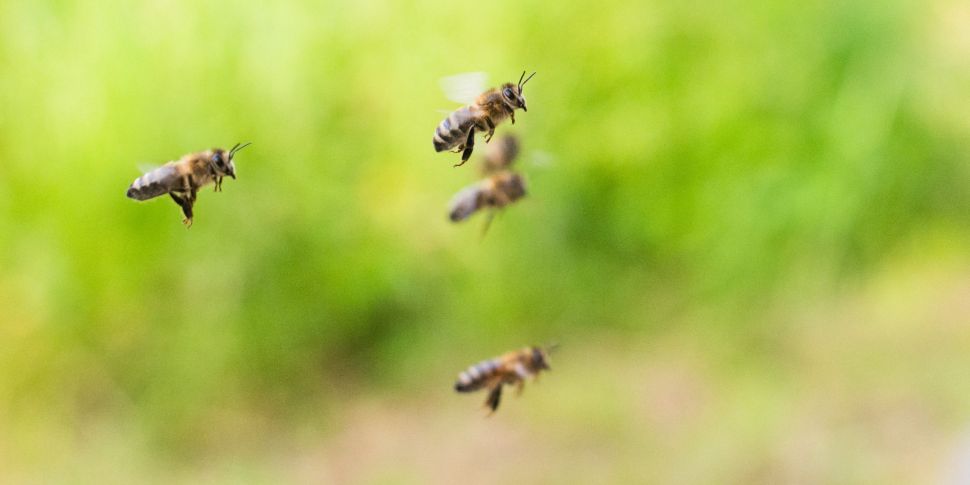How many bees does it take to make a teaspoon of honey? Well, on average a worker bee only produces 1/12th of a teaspoon of honey in its entire lifetime so on average, it would take twelve bees visiting millions of flowers and flying thousands of miles just to produce a single teaspoon of honey.
It is well documented that bee populations are declining worldwide. In Europe, one in ten bees and butterfly species are on the verge of extinction, and one third are in decline.
Professor Brian Ó Gallachóir, Director of MaREI – the SFI Research Centre for Energy, Climate and Marine, joined Pat Kenny on The Pat Kenny Show to discuss the declining number of bees in Ireland.
The role of bees in Ireland
In Ireland, we have one species of bee that isn’t in trouble and that's the honeybee. This is because honeybees are mostly managed by human beekeepers, who ensure that the population is maintained. However, there are 98 other species of wild bees in Ireland that are considered at risk and in decline.
"Firstly, this risk is due to the change in habitats that have come about, which limits their capacity to pollinate and to survive. And secondly, it’s caused by things like insecticides," Professor Ó Gallachóir explained.
Pollination is vital when it comes to the survival of bee species, but it is also vital for crop production and the associated food industry. While bees may be considered a stinging pest by some, they play an absolutely crucial role in cross-pollinating crops – moving pollen from the male anther of the flower to the female stigma of the flower. 80% of crops and wild flowering plant species in the EU depend, at least in part, on animal pollination.
Speaking about this dependency on bees, Professor Ó Gallachóir said that "around €3.7 billion of EU's annual agricultural output is directly dependent on insect pollinators, so the role that they play is critical. And what this recent EU analysis has found is that they're under stress. One in 10 bees and butterfly species in Europe is on the verge of extinction. And one third of them are in decline."
How can we help save the bee populations?
One of the biggest contributors to the decline in bee populations is climate change. The 2021 Environmental Protection Agency (EPA) Conference on Climate Change recently took place and focused on climate solutions for a better tomorrow. However, in relation to Ireland, the EPA published projections that show if everything that is planned by the Irish government is put in place and delivered, we may get a 24% reduction in greenhouse gas emissions by 2030. But the climate bill that's been passed by the Dáil and is currently going through the Seanad seeks an increase in ambition to a 51% reduction.
Effective policies are a key part of the solution, but citizens can also play an important role, as Professor Ó Gallachóir explains: "Citizens can engage through citizen science to monitor and track bee populations. Monitoring by citizen scientists has found that bumble bees are declining year on year, and there's been a moderate decline in some common butterfly species also."
Creating and nurturing habitats that encourage bees and pollination is another way to help and Professor Ó Gallachóir specifically called out Cellbridge and Castletown House as good examples of this practice. "...the meadows there have been nurtured and this biodiversity is key in terms of providing the correct habitats for the insect pollinators to survive, and then to be able to in turn secure the economic activity associated with the agriculture and the crops that we benefit from because of their activity."
So if you happen upon a bumblebee outside this summer, be mindful and enjoy the wonderful site instead of thinking about the fear of being stung, which so many of us do without thinking. If you see a bee in distress and are certain the bee isn't just resting before finding nectar nearby, you can mix up a 50/50 sugar and water solution and offer a couple of drops to the bee in a sheltered place. Even though this method is popular online right now with people sharing their efforts, it really should only be used as a last resort if the bee is clearly in distress and there are no suitable flowers nearby.
To learn more about our bee population, climate research and other interesting topics, you can tune into Professor Brian Ó Gallachóir on Green Scene, sponsored by ESB, on The Pat Kenny Show every Wednesday or catch up here.










